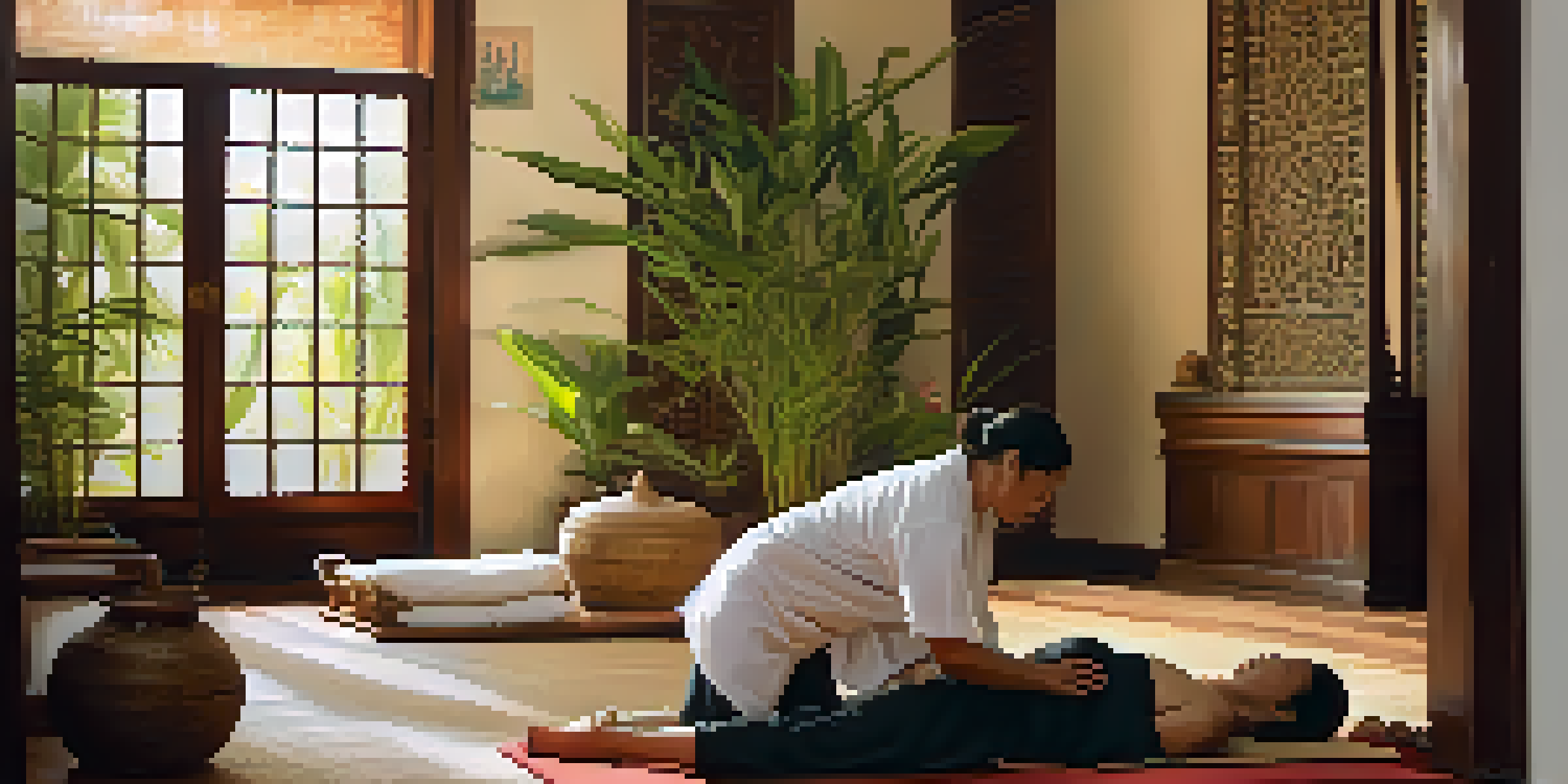The Role of Breath in Thai Massage Practices and Techniques

Understanding Breath's Role in Thai Massage
Breath is a vital component in Thai massage, acting as a bridge between the mind and body. In this ancient practice, breath helps facilitate relaxation and focus, allowing both the practitioner and the recipient to connect deeply. By emphasizing breath, Thai massage goes beyond mere physical manipulation to create a holistic healing experience.
Breath is the bridge which connects life to consciousness, which unites your body to your thoughts.
When clients are aware of their breathing, they can better release tension and open themselves to the healing process. This awareness creates an environment where energy can flow freely, enhancing the overall effectiveness of the massage. It’s a dance of sorts, where each inhale and exhale becomes a guide for movement and intention.
Moreover, practitioners often synchronize their movements with the recipient's breath, creating a rhythm that fosters a calming atmosphere. This synchronization not only improves the quality of the massage but also helps clients feel more engaged and present throughout the session.
Breath Techniques Used in Thai Massage
Various breath techniques are integral to Thai massage, each designed to enhance relaxation and energy flow. One popular method is 'ujjayi breathing,' which involves a slight constriction of the throat to create an ocean-like sound during exhalation. This technique not only calms the mind but also helps to stabilize the energy within the body.

Another technique, known as 'diaphragmatic breathing,' encourages deep abdominal breathing that promotes full oxygen exchange. This method can significantly reduce stress and anxiety, allowing clients to embrace the massage fully. Incorporating these techniques into the session helps in grounding the individual, making it easier for them to let go of physical and emotional tension.
Breath Enhances Thai Massage
In Thai massage, breath is crucial for relaxation, focus, and the holistic connection between practitioner and client.
Ultimately, these breathing techniques are not just about inhaling and exhaling; they are tools for transformation. They allow clients to journey inward and discover areas of discomfort or tension that need attention, guiding the practitioner in their approach.
The Connection Between Breath and Energy Flow
In Thai massage, breath is closely linked to the concept of 'prana' or life force energy. Practitioners believe that breath is the vehicle through which prana moves, nourishing the body and promoting healing. When breathing is smooth and deep, it facilitates a natural flow of energy, enhancing the benefits of the massage.
The breath is the vital link between the mind and body. Through breath, we can bring our mind back to the present moment.
Conversely, shallow or irregular breathing can indicate blockages or stress, which may hinder the effectiveness of the massage. By focusing on breath, both the client and the practitioner can work together to identify and release these blockages, ensuring a more fruitful experience. This process underscores the importance of breath as not just a biological function but as a means of emotional and energetic release.
Thus, encouraging clients to connect with their breath during a session can amplify feelings of vitality and well-being. This connection allows individuals to experience a profound sense of balance and harmony, both physically and energetically.
Breath Awareness as a Mindfulness Practice
Integrating breath awareness into Thai massage transforms the experience into a mindfulness practice. By focusing on their breath, clients can cultivate a sense of presence, grounding them in the moment. This mindfulness not only enhances relaxation but also encourages a deeper connection to their inner selves.
Practitioners often guide clients to notice their breath patterns before the session begins, inviting them to set intentions for their experience. This practice of intentional breathing can lead to a more meaningful interaction between the practitioner and the client, allowing for a personalized approach to healing.
Breath Techniques Improve Healing
Breath techniques like ujjayi and diaphragmatic breathing facilitate energy flow and emotional release during sessions.
Moreover, breath awareness can extend beyond the massage session, encouraging clients to incorporate mindfulness into their daily lives. This simple yet powerful practice can help reduce stress and improve overall well-being, reinforcing the benefits gained during the massage.
Breath and Release During Thai Massage Techniques
The release of tension during Thai massage is often facilitated by breath. As practitioners apply pressure or stretch the body, they encourage clients to exhale deeply, promoting the release of tight muscles and emotional stress. This connection between breath and release is fundamental in achieving a state of relaxation.
Clients may find that specific breathing techniques can help them navigate discomfort during more intense stretches or pressure points. By exhaling during these moments, they can soften their bodies and allow the practitioner to work more effectively. This collaboration creates a dynamic flow that enhances the overall experience of the massage.
Ultimately, this synergy between breath and technique cultivates a deeper sense of trust and safety, enabling clients to surrender more fully to the healing process. The more they engage with their breath, the more they can unlock the potential for profound release and renewal.
Breath as a Tool for Emotional Healing
Breath plays a crucial role not just in physical healing but also in emotional release during Thai massage. Many clients carry emotional tension in their bodies, which can manifest as tightness or discomfort. By focusing on breath, clients can begin to recognize and process these emotions, allowing for a more comprehensive healing experience.
Practitioners may encourage clients to vocalize or express feelings during the massage, using breath as a catalyst for emotional release. This process can be incredibly liberating, helping individuals to confront and let go of burdens they may have been carrying for years. It’s a deeply personal journey that underscores the interconnectedness of body, mind, and spirit.
Mindfulness Through Breath Awareness
Integrating breath awareness into daily routines promotes mindfulness and overall well-being, extending the benefits of Thai massage.
Through this lens, breath becomes a powerful ally in the pursuit of emotional well-being. As clients learn to navigate their emotional landscapes, they may find new pathways to healing and resilience, transforming their relationship with themselves.
Integrating Breath into Daily Wellness Routines
The lessons learned about breath in Thai massage can extend far beyond the treatment room. Integrating conscious breathing into daily routines can enhance overall wellness and mindfulness. Simple practices, such as taking a few moments each day to focus on deep breathing, can help reduce stress and increase mental clarity.
Clients can also explore other forms of bodywork or yoga that emphasize breath, reinforcing their connection to the practices learned in Thai massage. This holistic approach not only enhances physical health but also supports emotional balance, creating a well-rounded wellness routine.

Ultimately, the journey of breath awareness is a lifelong practice. By continually nurturing this connection, individuals can cultivate a deeper sense of peace and vitality, making breath a foundational element of their overall health and happiness.